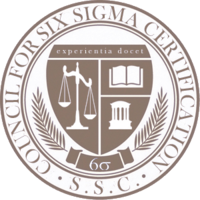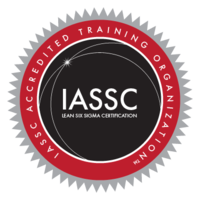Description
What is Lean Six Sigma Black Belt Online Training?
The Lean Six Sigma Black Belt training takes organizations to the next level by uniting product and process excellence with goals such as improving customer service and/or enhancing shareholder value creation. Leaders in today’s organizations are turning to the Lean Six Sigma Black Belt training to ensure their competitive edge, improve service and build the skill base needed to sustain performance improvement. The Black Belt Course is designed to improve process performance, deliver high-impact projects and achieve significant cost savings. The Certified Lean Six Sigma Black Belt is a professional who can explain Lean Six Sigma philosophies and principles, including supporting systems and tools. Black Belts will demonstrate team leadership, understand team dynamics and assign team member roles and responsibilities. Black Belts will gain thorough understanding of all aspects of the DMAIC model in accordance with Six Sigma principles. Black Belts will gain knowledge of Lean enterprise concepts, are able to identify non-value-added elements and activities.
The eLearning modules are professionally narrated with interactive quizzes, hence you will receive the best online Black Belt course available in the market. All delivered through a system that you will have access to 24 hours a day, 7 days a week. Course Access for this programmes is 12 months from date of purchase.
Our Yellow Belt is rated at 45 hours for completion, our Green Belt is rated at 85 hours for completion, and our Black Belt is rated at 105 hours for completion. Because of the online nature of the course, you will be able to navigate the course in a manner that is most suitable to your own work habits. Most students are able to successfully complete the Black Belt (our longest certification) within 6 months of registration, with some of the more aggressive students certifying in as few as 3 months.
You can take a Quiz to determine which Six Sigma course you are best suied for : Six Sigma Programme Eligibility Quiz
Training Features
- 12 months access to online training programme
- Professionally Narrated eLearning Modules
- Matching Interactive Quizzes
- 5 Chapter Tests (one for each DMAIC phase)
- Self-phased study. You can stop anytime as you progress and re-start from the point you left off. (Within 12 months)
- For best performance use Chrome as your browser
- Upon completion of your e-learning you will be provided a Six Sigma Black Belt certification of completion.
- For IASSC Certification (optional) you may book your exam through this link (IASSC Certification Exam), and make payment therein for the web proctored exam.
- 98% Satisfaction Rating
- Over 790 courses completed
System Features
- System Availability 24 x 7
- Internal Messaging System
- Glossary and Forum
- Additional Exercises
- Supplemental Study Units
Six Sigma Black Belt Online Learning Requirements
- Complete All eLearning Modules & Quizzes
- Pass All Five D.M.A.I.C. Tests (80% or better)
- Upon completion of eLearning you will receive a letter of e learning completion
- Our consultants will email you a short assignment to be completed
- Upon completion of the short assignment you will be awarded with the black belt certification
Accreditation - BOK (Body of knowledge)

Our Lean Six Sigma Black Belt online training is recognized industry wide! Earning your online training from Lean Sigma Experts Australia (LSEA) means you have successfully demonstrated mastery of the Lean Six Sigma body of knowledge consistent with all industry recognized training providers. Our content and body of knowledge is aligned to ASQ, IASSC and more importantly, accredited by the Council for Six Sigma Certification.
The Council for Six Sigma Certification is a professional association devoted to ensuring that curriculum providers and training programs maintain minimum standards for both Six Sigma certification and Lean Six Sigma certification. The Council provides accreditation services to more than 165 countries around the world and have accredited numerous universities, 3rd party training firms, consultants and individual trainers.

Lean Sigma Experts Australia (LSEA) is an Accredited Training Organisation and Examination Center by IASSC (International Association for Six Sigma Certification)
Six Sigma Black Belt Online Learning Curriculum
1.1 Six Sigma Overview
1.1.1 What is Six Sigma
1.1.2 Six Sigma History
1.1.3 Y = f(x) Approach
1.1.4 Six Sigma Methodology
1.1.5 Roles & Responsibilities
1.2 Fundamentals of Six Sigma
1.2.1 Defining a Process
1.2.2 VOC & CTQ’s
1.2.3 QFD
1.2.4 Cost of Poor Quality
1.2.5 Pareto (80:20 rule)
1.3 Lean Six Sigma Projects
1.3.1 Six Sigma Metrics
1.3.2 Business Case & Charter
1.3.3 Project Team Selection
1.3.4 Project Risk Management
1.3.5 Project Planning
1.4 Lean Fundamentals
1.4.1 Lean & Six Sigma
1.4.2 History of Lean
1.4.3 The Seven Deadly Muda
1.4.4 Five-S (5S)
2.1 Process Definition
2.1.1 Cause & Effect Diagrams
2.1.2 Cause & Effects Matrix
2.1.3 Process Mapping
2.1.4 FMEA
2.1.5 Theory of Constraints
2.2 Six Sigma Statistics
2.2.1 Basic Statistics
2.2.2 Descriptive Statistics
2.2.3 Distributions & Normality
2.2.4 Graphical Analysis
2.3 MSA
2.3.1 Precision & Accuracy
2.3.2 Bias, Linearity & Stability
2.3.3 Gage R&R
2.3.4 Variable & Attribute MSA
2.4 Process Capability
2.4.1 Capability Analysis
2.4.2 Concept of Stability
2.4.3 Attribute Capability
2.4.3 Discrete Capability
2.4.4 Monitoring Techniques
3.1 Patterns of Variation
3.1.1 Multi-Vari Analysis
3.1.2 Classes of Distributions
3.2 Inferential Statistics
3.2.1 Understanding Inference
3.2.2 Sampling
3.2.3 Sample Size
3.2.4 Central Limit Theorem
3.3 Hypothesis Testing
3.3.1 Hypothesis Testing Goals
3.3.2 Statistical Significance
3.3.3 Risk; Alpha & Beta
3.3.4 Types of Hypothesis Test
3.4 Hyp Tests: Normal Data
3.4.1 One and Two Sample t-tests
3.4.2 One Sample Variance
3.4.3 One Way ANOVA
3.5 Hyp Tests: Non-Normal
3.5.1 Mann-Whitney & Mood’s Median
3.5.2 Kruskal-Wallis
3.5.3 Moods Median
3.5.4 Friedman
3.5.5 1 Sample Sign
3.5.6 1 Sample Wilcoxon
3.5.7 1 and 2 Proportion
3.5.8 Chi-Squared
3.5.9 Test of Equal Variances
4.1 Simple Linear Regression
4.1.1 Correlation
4.1.2 X-Y Diagram
4.1.3 Regression Equations
4.1.4 Residuals Analysis
4.2 Multiple Regression
4.2.1 Non-Linear Regression
4.2.2 Multiple Linear Regression
4.2.3 Confidence Intervals
4.2.4 Residuals Analysis
4.2.5 Box Cox Transformation
4.2.6 Stepwise Regression
4.2.7 Logistic Regression
4.3 Designed Experiments
4.3.1 Experiment Objectives
4.3.2 Experimental Methods
4.3.3 DOE Considerations
4.4 Full Factorial Experiments
4.4.1 2k Full Factorial Designs
4.4.2 Linear & Quadratic Models
4.4.3 Orthogonal Designs
4.4.4 Model & Center Points
4.5 Fractional Factorials
4.5.1 Designs
4.5.2 Confounding Effects
4.5.3 Experimental Resolution
5.1 Lean Controls
5.1.1 Control Methods for 5S
5.1.2 Kanban
5.1.3 Poka-Yoke
5.2 SPC
5.2.1 Data Collection for SPC
5.2.2 I-MR Chart
5.2.3 Xbar-R Chart
5.2.4 U Chart
5.2.5 P Chart
5.2.6 NP Chart
5.2.7 X-S chart
5.2.8 CumSum Chart
5.2.9 EWMA Chart
5.2.10 Control Methods
5.2.11 Control Chart Anatomy
5.2.12 Variation & Sampling
5.2.13 Control Limits
5.3 Six Sigma Control Plans
5.3.1 Cost Benefit Analysis
5.3.2 Control Plan Elements
5.3.3 Response Plan
*Kindly note that once an Online training is purchased and activated no refunds are permitted.


Reviews
There are no reviews yet.